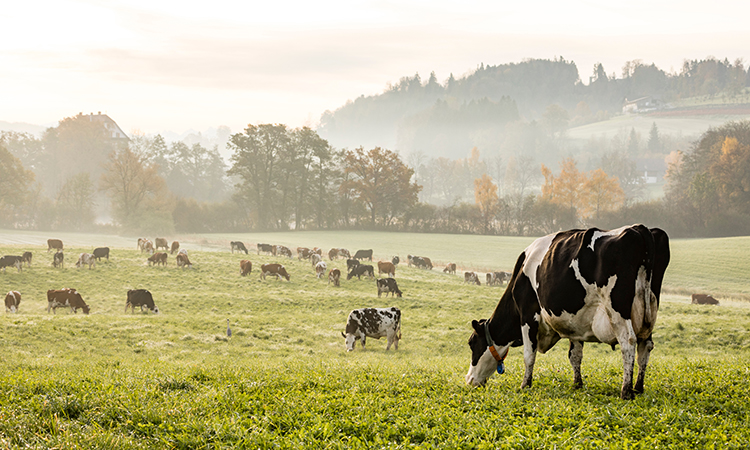Local approach needed to tackle emissions in livestock industry
- Like
- Digg
- Del
- Tumblr
- VKontakte
- Buffer
- Love This
- Odnoklassniki
- Meneame
- Blogger
- Amazon
- Yahoo Mail
- Gmail
- AOL
- Newsvine
- HackerNews
- Evernote
- MySpace
- Mail.ru
- Viadeo
- Line
- Comments
- Yummly
- SMS
- Viber
- Telegram
- Subscribe
- Skype
- Facebook Messenger
- Kakao
- LiveJournal
- Yammer
- Edgar
- Fintel
- Mix
- Instapaper
- Copy Link
Posted: 2 February 2021 | Joshua Minchin (New Food) | No comments yet
A study has revealed the benefits of a more localised approach in the battle to drive down emissions within the livestock industry, with a new web tool designed for farmers to assess the carbon footprint of their farms.


Are traditional sampling methods missing some strains of Salmonella?
The agricultural industry, in particular the livestock sector, is responsible for a sizeable chunk of global greenhouse house gas (GHG) emissions. Yet a study from the Euro-Mediterranean Center on Climate Change (CMCC) has been looking at way in which the so-called “land sector” can become a solution to the climate crisis, rather than one of its main drivers.
“The land sector has the unique characteristic to be at the same time both a contributor to climate change and part of its solution, thanks to the carbon sink function in soils and biomass that can be enhanced by an appropriate and sustainable land management” explained Maria Vincenza Chiriacò, CMCC researcher and lead author of the study.
“Our proposed land-based approach consists of two consecutive steps: we first assess the GHG emissions from the livestock activities, that is carbon footprint, in a small-scale rural area, then we evaluate the mitigation potential of a set of land-use options against the livestock emissions assessed in the previous step.
“Our aim is to understand the extent to which land-based mitigation options at a small-scale landscape level can lead to carbon neutral livestock systems”.
CMCC scientists claim they developed a land-based approach by combining different methodologies, including geographic information system (GIS) elaboration, life cycle assessment (LCA) and methodologies from the Intergovernmental Panel on Climate Change (IPCC), to investigate how and how much GHG emissions from livestock activities can be decreased and compensated through carbon removals in the same area.
They tested the approach on a pilot area in central Italy corresponding to a portion of the Municipality of Viterbo (in the Lazio region).
“The results show the potential for a total offsetting of the livestock GHG emissions in the pilot area, indicating possible pathways for the carbon neutral livestock systems,” said Professor Riccardo Valentini (CMCC Foundation and University of Tuscia).
“Depending on the type and intensity of the land-based mitigation options, the results also suggest the possibility to turn the system into a net carbon sink, producing negative emissions in the land sector that can significantly contribute to global climate change mitigation targets.”
“It’s important to highlight the idea of proximity of our land-based approach,” added Maria Vincenza Chiriacò.
“There are already many existing mechanisms of carbon offsetting, but they work on a logic of carbon compensation on a global scale, where the carbon removals usually take place in areas that are geographically far from those in which the emissions to be compensated are generated.
“In our study, instead, mitigation is achieved through the implementation of land-based mitigation options that reduce emissions or increase carbon sink in the immediate proximity of GHG source.
“This, besides contributing to the global climate change mitigation targets, entails a wide-ranging improvement of the entire agro-ecosystem at local scale, providing co-benefits that involve the local rural communities as well as the local institutions and the citizens that can gain in terms of environmental co-benefits, quality of life and territorial image.”
The proposed land-based approach has been recently developed in a web tool. Designed and developed by the CMCC and Istituto di Servizi per il Mercato Agricolo Alimentare (ISMEA), with the financial support of the Rete Rurale Nazionale 2014-2020 programme, the tool is freely available online. The web tool is based on rigorous scientific information (IPCC methodology), but its developers say it’s designed to be easy to use for everyone.
The platform allows Italian livestock farmers to assess the carbon footprint of their farms by compiling a simple online questionnaire that considers the main characteristics of their livestock systems. Then, they can also assess the potential of sustainable land-based options needed to reduce and compensate their livestock emissions.
It is hoped the web tool will help farmers, policy makers, and other relevant stakeholders in recognising the best options for sustainable land management, in particular at the small-scale rural landscape level.
Related topics
Environment, Research & development, Supply chain, Sustainability, Technology & Innovation
Related organisations
Euro-Mediterranean Center on Climate Change (CMCC), Istituto di Servizi per il Mercato Agricolo Alimentare (ISMEA), Rete Rurale Nazionale 2014-2020, University of Tuscia









